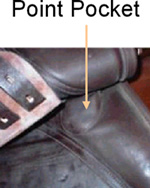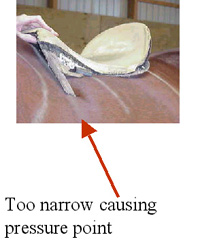
To find the points, lift the flap of the saddle and look for a little leather pocket into which the processes of the pommel are fitted. This is the point pocket and there is one on both sides of the pommel of the saddle just under the stirrup bars. These points should lie parallel to the withers.
 If the angles are too narrow, the points will dig into the musculature, also causing the middle of the saddle to be in uneven contact with the horse's back. If they are too wide the saddle will sit down in front putting pressure on top of the withers. To assess the point angels, stand looking from the front with the flap lifted; the points should be parallel with the musculature within 10 degrees of the heaviest side. Some points are concealed making it difficult to determine their angles. If this is the case, you will have to rely more on the panel pressure procedure to determine if the point angles are correct.
If the angles are too narrow, the points will dig into the musculature, also causing the middle of the saddle to be in uneven contact with the horse's back. If they are too wide the saddle will sit down in front putting pressure on top of the withers. To assess the point angels, stand looking from the front with the flap lifted; the points should be parallel with the musculature within 10 degrees of the heaviest side. Some points are concealed making it difficult to determine their angles. If this is the case, you will have to rely more on the panel pressure procedure to determine if the point angles are correct.